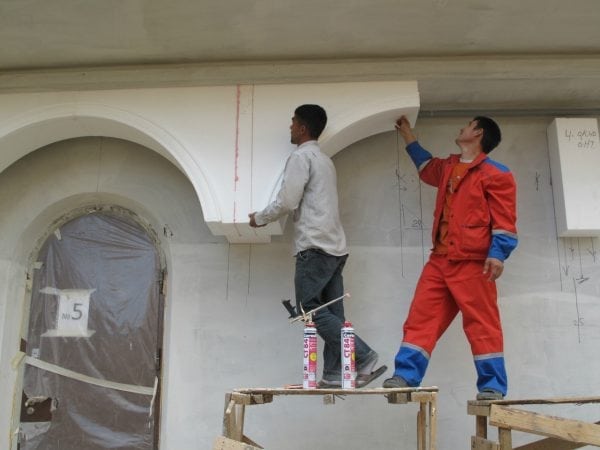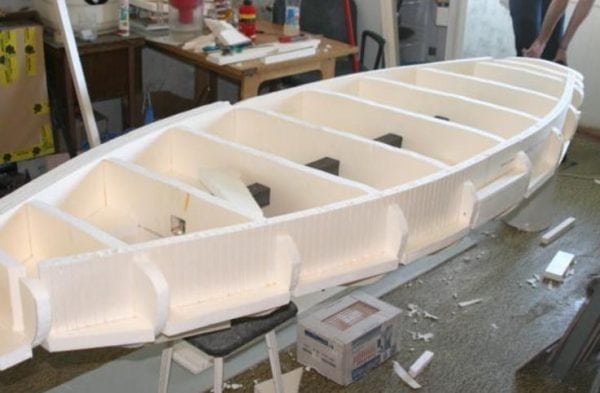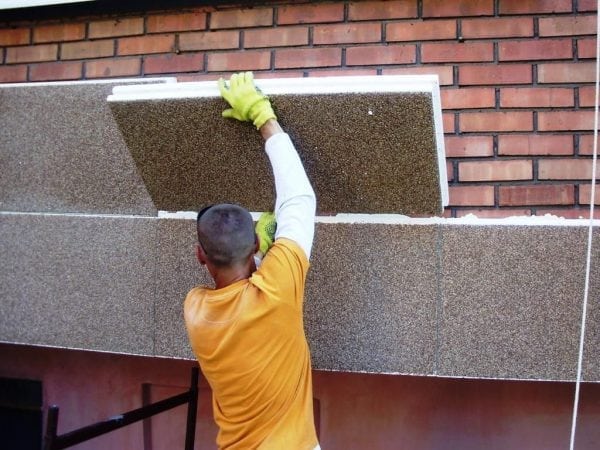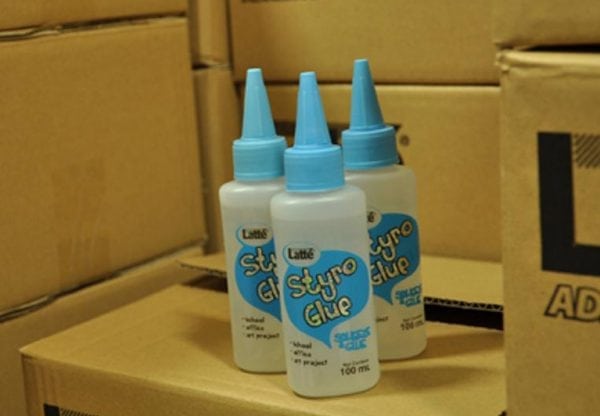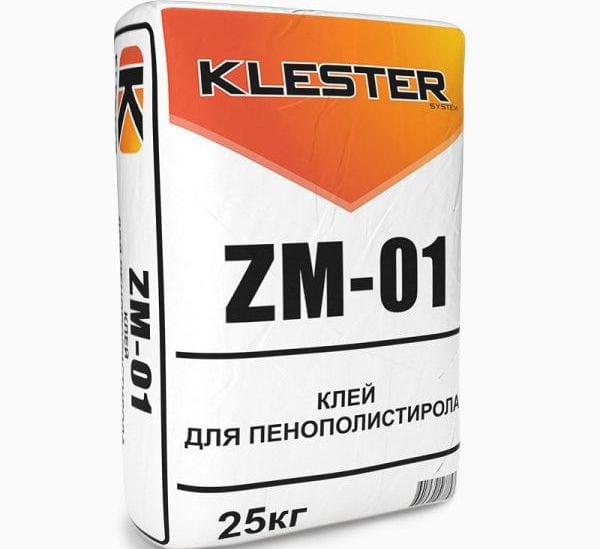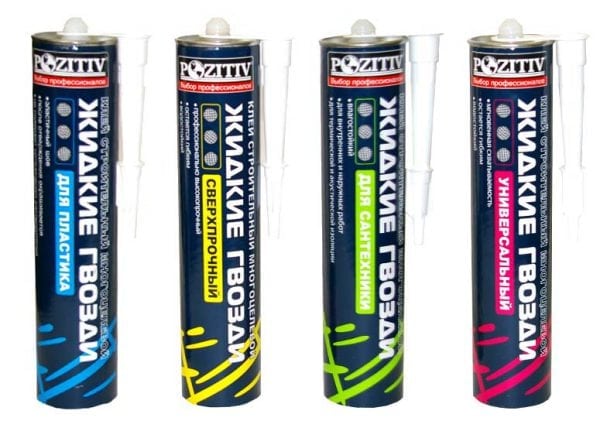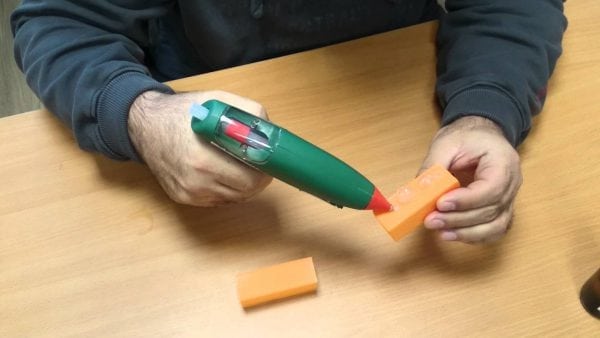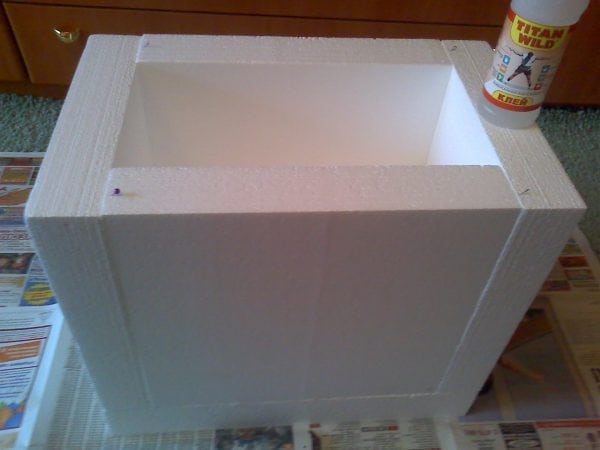Polyfoam (expanded polystyrene) - a popular material for wall insulation, ceiling, it is often used in the repair of premises, buildings. For applying it in decoration it is important to know the nuances of fastening. In the process, it is important to use reliable adhesives. How to glue the foam together, which means are better, which can not be used - we will consider in detail.
- Prohibited adhesives - what is not used for foam
- Glue selection
- Special Styrofoam Products
- Dry mixes
- Polyurethane foam
- Polyurethane foam
- PVA glue
- Liquid Nails
- Aerosol adhesives
- Epoxy adhesive
- Hot glue
- Bitumen glue
- Bonding foam and extruded polystyrene foam
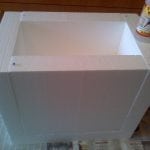
Prohibited adhesives - what is not used for foam
Usually, it is necessary to connect the foam where it is necessary to perform a more durable, powerful design of insulation. Often, material of small thickness is acquired (it is an order of magnitude cheaper), and gluing will allow you to achieve the desired characteristics of thermal insulation. Also, the connection of pieces of polystyrene is practiced in crafts.
What glue can be used when joining expanded polystyrene? Before buying, you must carefully read the information on the package. It is important that the composition does not contain harmful additives that destroy the material:
- derivatives of oil, natural gas;
- acetone, toluene, xylene, other solvents;
- acids - hydrochloric, sulfuric, nitric;
- alcohol components.
All of these ingredients are capable of destroying the surface and structure of the foam, so they are not used for gluing it. Simply put, if there is any combustible component in the composition, it is better to refuse the agent. Such substances are harmful to plastic, and polystyrene is just its foamed particles.
Before starting work at home, it is advisable to conduct a simple test. The technique of its implementation is as follows:
- Break off a piece of foam. Put a drop of purchased glue on it.
- In half an hour to evaluate the result. In the presence of spots, pits, "burns", signs of destruction, glue will have to be replaced.
to contents ↑Usually, specialized glue for other materials, such as rubber, fabric, wood, is not suitable for working with polystyrene foam. Universal tools are more suitable for the installation of expanded polystyrene.
Glue selection
The range of adhesives is very diverse. On sale there are special adhesives for plastic and polystyrene foam, liquid nails and foam in cylinders, epoxy and polyurethane adhesives, dry mixes. When selecting, it is important to consider the amount of installation work and the bonding area, the skills of the master, the estimated budget.
Here are some suggestions for choosing:
- if the foam sheets are glued to the facade of the building, you need to choose frost-resistant products, mixtures with silicone, liquid nails (it is recommended to use building dowels to improve strength);
- when laying a plate in a supporting frame, liquid nails, bituminous mastics, silicone adhesives are used;
- for cladding uneven walls, you can use adhesive mixtures on a dry basis.
to contents ↑Before starting work, it is important to evaluate the degree of preparation of the plates. If there is dirt, dust, residues of other adhesives, other unknown contaminants, the base must be cleaned. Otherwise, the degree of adhesion will decrease even if the highest quality glue is used.
Special Styrofoam Products
At the heart of such products is liquid polyurethane foam with modifying additives; the bank most often has the note “Styroglue”. Glues are not sold in every store, but their cost is low. Polystyrene glue is suitable for all types of foam, but it is also suitable for other materials - plastic, wood.
The advantages of the composition are as follows:
- optimal structure, density - suitable just for a porous insulation;
- colorless - glue will not be noticeable on white foam;
- moisture resistance, prevention of mold, frost resistance - the properties are suitable for outdoor and indoor use;
- quick drying - dries in 20-60 seconds.
The minor disadvantages include the need to work with gloves - the glue adheres firmly to the skin, it is difficult to wash it. It gets very thick in the cold, it is better to put the jar in a container with hot water.
to contents ↑Dry mixes
It is possible to glue polystyrene foam with the help of powder adhesives. The packaging must indicate suitability for insulation. Before use, the mass is diluted with water, stirred with a stick or whipped with a construction mixer, after which it is ready for use. Apply the mass to the polystyrene sheets with a spatula. Advantages are obvious:
- the ability to fill the seams between the plates, smooth uneven joints during the installation process (this creates the most durable structure);
- frost resistance, water resistance, tightness;
- environmental friendliness, harmlessness to humans.
The disadvantages include the fact that the mixture is not suitable for foil foam, polystyrene foam.
to contents ↑Polyurethane foam
Such adhesives differ from the specialized tools described above only in the form of release and a number of additives. The composition allows you to glue the foam very tightly, while filling all the voids between the two sheets. The expansion of polyurethane foam is negligible, material deformation will not happen.
to contents ↑To use the foam, an assembly gun will be required; work is carried out with gloves. Foam is applied to the edges and in the center of the sheet in stripes. After 10 seconds, another sheet is leaned against it, the position is fixed.
Polyurethane foam
It is less effective to glue the foam with each other with mounting foam. It is expensive, the expense is high. The expansion of ordinary foam is high, this leads to a shift of the insulation sheets. Terms of work increase, because the foam dries longer than glue.
PVA glue
PVA is familiar to everyone, even those who have not encountered construction and installation works. The connection using PVA is not as strong as when applying special formulations. Therefore, gluing the foam to the foam with this glue is possible only when creating crafts. It is easy to work with, the use of gloves and respiratory protection is not required. Apply glue to both pieces of material, allow the product to dry. After applying another layer and press the parts for 2-4 minutes.
to contents ↑Liquid Nails
Initially, adhesives such as "liquid nails" very firmly glue the foam, but over time, the adhesion quality may decrease. Also, the disadvantages include the high cost of repair, which is disadvantageous to the user. There is an exit. Apply “liquid nails” in dotted stripes, alternating them with cheaper and more durable glue (1: 1 ratio).
to contents ↑Aerosol adhesives
Such tools are universal, suitable for most materials, while not spoiling the sheets of foam. They quickly set and are used for small tiles of material - in large areas it is technically difficult and economically disadvantageous. Aerosols are convenient to use in hard to reach places. Usually they are bought for the installation of foam as an additional, auxiliary tool.
Epoxy adhesive
Epoxy adhesives are two component formulations.Base and hardener are sold in two packs. Mix the components immediately before starting work. Glue perfectly holds foam panels together. They can also be epoxy coated on top. This will create a smooth, durable, perfectly even surface that resembles stone. The lack of glue is in its high cost.
Hot glue
It is difficult to use hot glue for polystyrene foam. If it overheats, it will easily burn through brittle material. When applied to plastic products, hot-melt adhesive can emit harmful fumes. Among other things, it freezes after application in a few seconds, you will have to work quickly. Hot melt is useful if you need to connect several parts into a solid structure, while long-term work is not planned.
to contents ↑Bitumen glue
Bitumen adhesives, or mastics, are made on the basis of bitumen - an excellent astringent component that can reliably bond different materials. Bitumen mastic dries quickly, does not suffer from the effects of low or high temperatures. For gluing sheets of insulation glues are sold in small banks, you can apply them even with a regular stick. The composition will completely dry in 4-6 hours, grasp in 20-30 minutes.
Bonding foam and extruded polystyrene foam
For bonding between simple foam parts and products from extruded polystyrene foam, all of the above compositions can be used. The properties of the materials and their reaction to adhesives are similar, because they differ only in manufacturing technology.
There is only one caveat - before gluing, the extruded polystyrene foam must be treated with a roller with needles. This will help improve adhesion to the foam, because the surface of the material is smooth, glossy. So the fixation of parts will be reliable and will remain for many years!

